Connecting with the Snoqualmie River
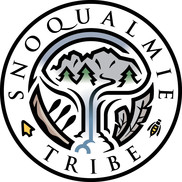
How do you connect with the Snoqualmie River? The Snoqualmie Tribe is studying the river in the Upper Snoqualmie Corridor and will develop a plan to share how conditions are expected to change in a warming climate. The Tribe invites stories to hear your thoughts and feelings about the Snoqualmie River, changes, and a resilient future. The tribe will share a survey next month to invite your thoughts and creative responses through storytelling, art submissions, photos, videos, and more!
If you have any questions or would like to schedule an interview with the project team, contact Matt Baerwalde at Mattb@snoqualmietribe.us or 425-495-4111
|
 Snoqualmie Valley Preservation Alliance launches Floodzilla Network
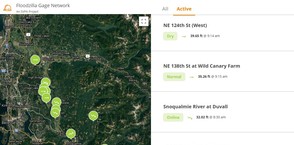
The Snoqualmie Valley Preservation Alliance (SVPA) team has been hard at work all summer preparing to launch the Floodzilla Gauge Network - a network of gauges integrated into one easy to use website.
Ten SVPA gauges in the lower valley read water levels every fifteen minutes and upload the data real time so valley users, farmers, commuters, and land managers can track floods while they are happening. The website integrates SVPA gauges and USGS gauges into one interface. If you would like to be part of our notification beta testing group, sign in to create an account. You can select which gauges are of interest to you. The project is made possible by the hard work of team volunteers, staff, community members, SVPA donors, and a significant grant from the King County Flood Control District.
|
 Snoqualmie Indian Tribe restoring the Snoqualmie Floodplain
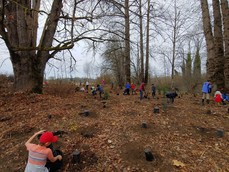
The Snoqualmie Indian Tribe began working on the Fall City Floodplain Restoration Project (Formerly the Hafner-Barfuse Floodplain Project) in late 2019, partnering with King County to restore critical salmon spawning habitat on the Snoqualmie River. The project is identified as one of the important large capital projects moving forward in the Fish Farm Flood (FFF) agreement.
During the project’s first planting season, blackberry understory was cleared across 4 acres, treatment started on knotweed, English Ivy, English Holly, and clematis, and almost 5,000 trees and shrubs were planted by volunteers, staff, and Washington State Conservation Crews (WCC). As the work goes on, blackberry continues to be removed, planting plans are being adapted to progress through the pandemic, and on any day, you can observe the effects of returning birds and beavers on the landscape.
Planting more conifers and removing more noxious weeds is planned for 2021 to continue restoring ecosystem processes. As King County moves forward with levee removal and construction, and as the Snoqualmie Tribe begins planting an 8-acre field, this site will become less recognizable to recent memory, and more recognizable to natural history.
|
 Snoqualmie Valley Watershed Improvement District - Fish Screen Program
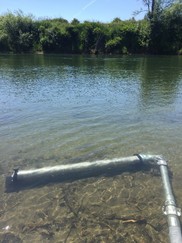
The Snoqualmie Valley Watershed Improvement (SVWID) launched a Fish Screening Program in 2018 to help Snoqualmie Valley farmers upgrade fish screening equipment on intake pumps to state and federal standards to protect fish life. Washington Department of Fish and Wildlife (WDFW) is the state agency that enforces and helps farmers with fish screen compliance. WDFW has worked closely with the SVWID to make this program successful. WDFW provides technical assistance and the SVWID identifies and connects with farmers needing screening upgrades; a testament to not only the positive working relationship between WDFW and the SVWID but also the SVWIDs unique working relationship with valley farmers. This program is run by the SVWID’s fish biologist, Andy Obst. In the first year alone, Andy achieved an unprecedented 100% program participation. To date, twenty-six fish screens have been recommended and purchased for twenty valley farmers. The goal of the Program is to screen all surface water diversions within the valley. Funding for this program has come from Ecology, King County’s Agricultural Best Management Practices Cost-Sharing Program, the King County Flood Control District, the Snoqualmie Watershed Forum, and WDFW.
|
 Coho Prespawn Mortality Investigation in the Snohomish Basin
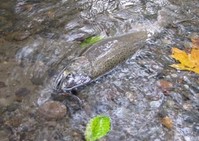
The Snoqualmie Watershed Forum was awarded a $164,500 National Estuary Program (NEP) grant through the Near-Term Action process for work beginning this fall. The grant will support investigations across urban areas in the Snohomish basin to determine whether coho salmon are being prevented from spawning due to polluted stormwater runoff from roads. In partnership with Tulalip Tribes, King County and the Snohomish and King Conservation districts, and Forum staff will search for signs of coho pre-spawn mortality in urban streams in King and Snohomish counties this winter and next. To alleviate impacts where coho pre-spawn mortality is found, technical assistance will be offered to businesses and municipalities. Please reach out to Elissa Ostergaard, Snoqualmie Salmon Recovery Manager with questions at elissa.ostergaard@kingcounty.gov or 206-477-4792.
|
 Fall City Floodplain Restoration Project Open House

King County will host an online community meeting, Oct 28 and a virtual open house from Oct. 26 - Nov.9 for people to learn about the Fall City Floodplain Restoration Project that will reconnect the floodplain and restore this historically productive area for salmon.
The project team will present the initial project design, schedule, answer questions, and take feedback during the online community meeting (registration is required). All project information will be posted on the virtual open house for those who are unable to attend the online community meeting.
|
 Thanks for reading! We're happy you've chosen to learn more about the great work being accomplished to support fish, farms, and flood safety in the Snoqualmie Valley. If you have any questions, check out our website!
If you have a relevant news story or article you would like us to share, please email Beth leDoux at beth.ledoux@kingcounty.gov.
Let's connect! Follow us and say hello over on our King County Instagram, Twitter, and Facebook accounts!
|